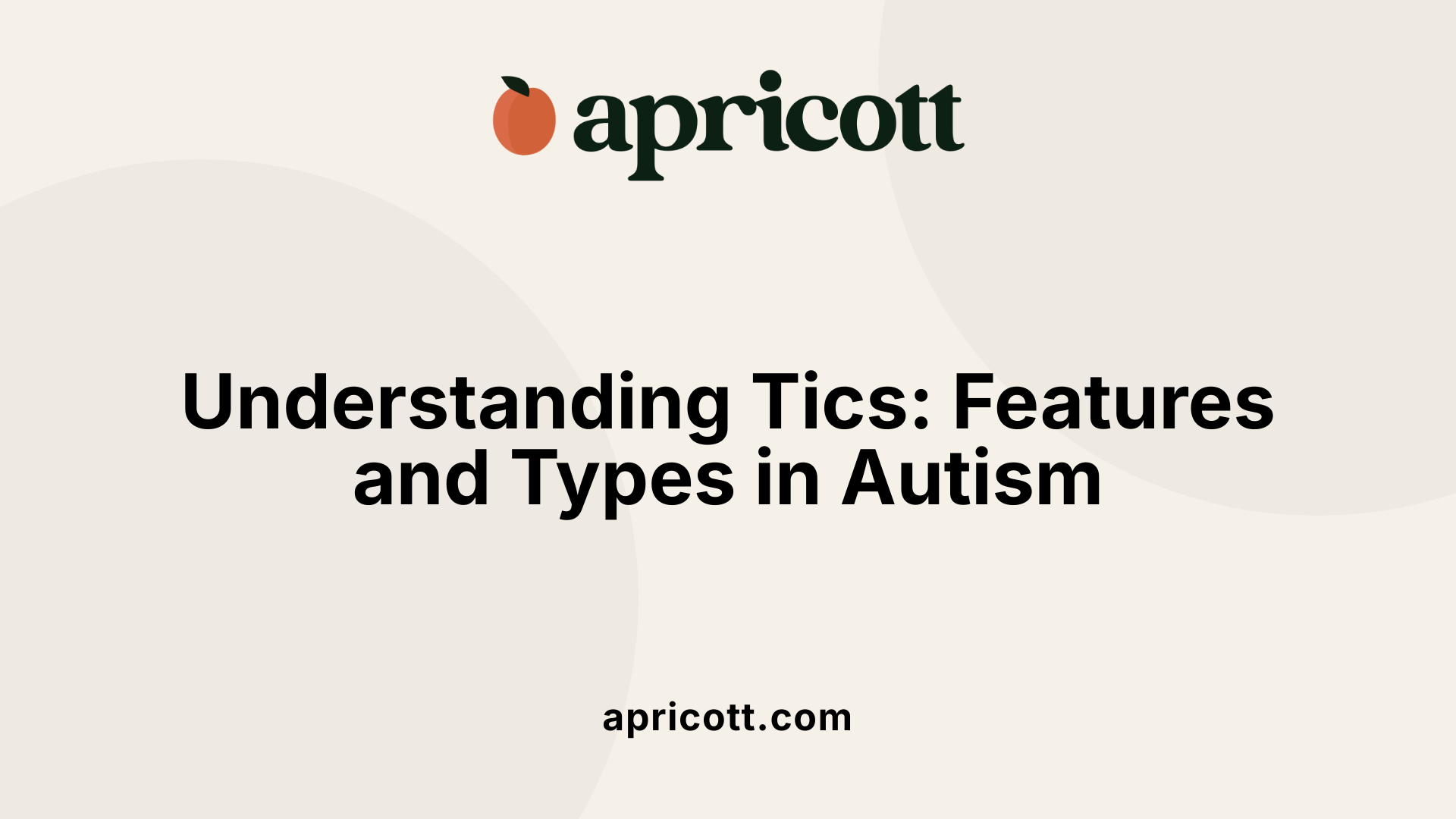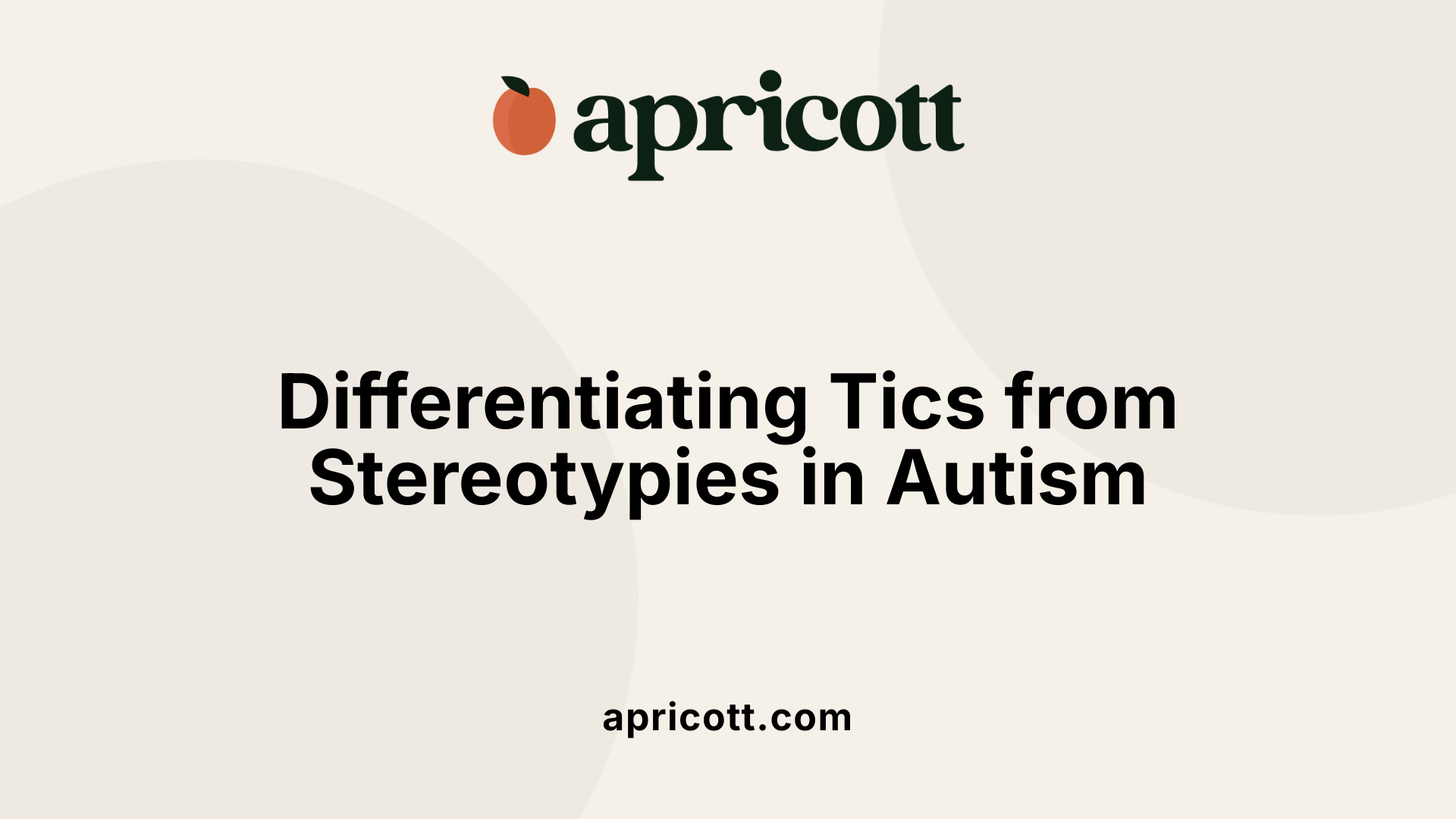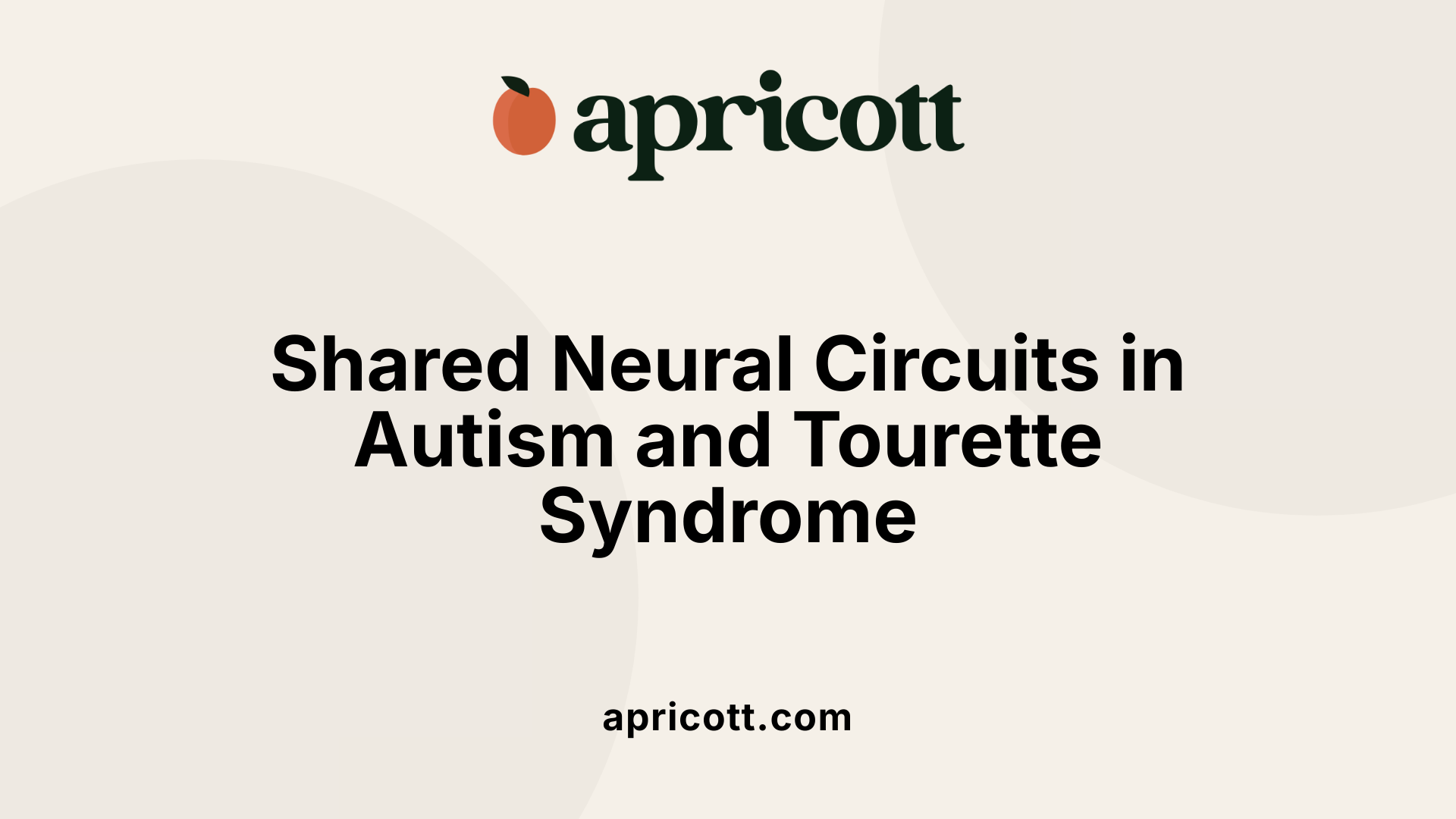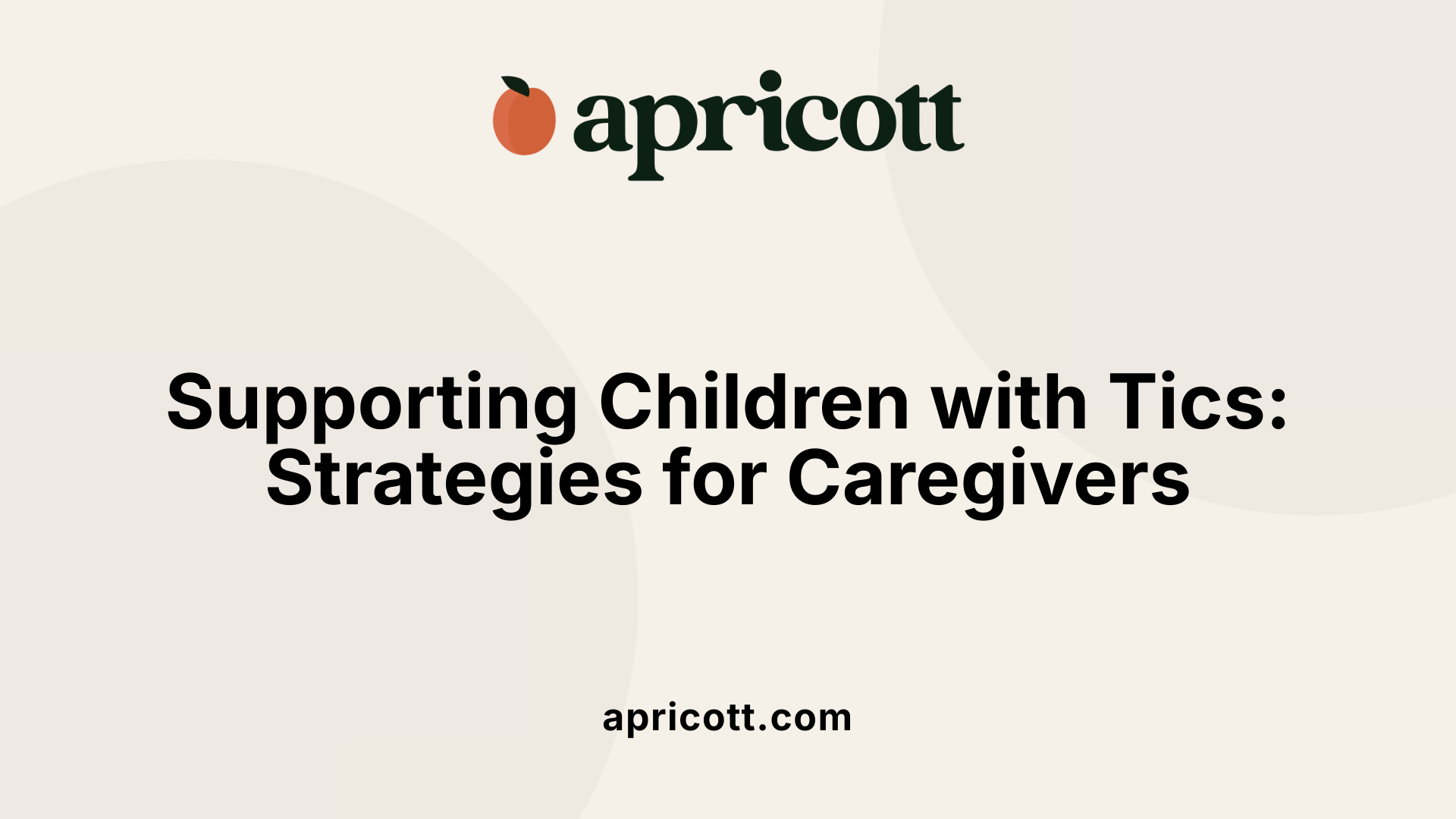July 24, 2025
Understanding the Complexities of Tics within Autism Spectrum Disorder
Autism spectrum disorder (ASD) is a neurodevelopmental condition characterized primarily by challenges in social communication and repetitive behaviors. While stereotypies and self-stimulatory behaviors are common in ASD, tics—rapid, involuntary movements or sounds—also frequently co-occur. This article delves into the relationship between autism and tics, examining their characteristics, differentiation from other repetitive behaviors, prevalence, neurobiological underpinnings, and modern approaches to management.
Tics are fairly common among individuals with autism spectrum disorder (ASD), with recent studies indicating that approximately 9-12% of autistic individuals exhibit tic behaviors. These tics are involuntary, fast, repetitive movements or sounds, including motor tics like eye blinking, nose twitching, or shoulder shrugging, and vocal tics such as throat clearing or sniffing.
Compared to Gilles de la Tourette syndrome (GTS), a well-known tic disorder, tics in ASD tend to be less severe and less frequent. In adults with ASD, the pattern and types of tics resemble those in GTS, often following a rostrocaudal distribution—meaning they typically begin in the face and head region before affecting other body parts.
Interestingly, many individuals with ASD are unaware they are performing these tics, unlike in GTS, where awareness is common. This limited awareness might be due to deficits in self-referential processing and social perception, which are characteristic of ASD.
Tics in autism are considered semi-voluntary responses to internal sensations or urges, often building until performed to relieve discomfort. They can be distinguished from behaviors like stimming—purposeful actions used for self-regulation—by their involuntary nature. The severity and frequency of tics in ASD can shift, often increasing during times of stress or fatigue.
Although the precise neurobiological underpinnings are still being studied, evidence suggests a shared neural basis involving the basal ganglia and related corticostriatal circuits. These brain areas are crucial in controlling movements and are implicated in both ASD and tic disorders.
The main difference lies in the individual's awareness and the severity of symptoms. All GTS patients typically recognize their tics and often experience premonitory urges—they feel an internal sensation that precedes the tic.
In ASD, awareness of tics is limited; only about half of those exhibiting tics are aware of them. This lack of insight could influence how tics are managed and how behaviors are interpreted.
Tics in GTS are usually more intense and disruptive, whereas in ASD, they tend to be milder. Despite these differences, the types of tics can be similar across both conditions, including simple and complex motor and vocal tics.
Both ASD and GTS show evidence of neurobiological overlap, particularly involving the basal ganglia and corticostriatal pathways. These brain regions regulate involuntary movements and behavioral responses.
The imbalance in neurotransmitters like dopamine within these circuits is believed to contribute to the development of tics. Understanding this shared pathway helps in exploring common treatment strategies and enhances our understanding of the neurodevelopmental aspects of these conditions.
Awareness of tics is a notable difference: all GTS participants recognize their tics, which often causes a sense of premonitory urge, while only about five out of ten ASD individuals with tics are aware of their symptoms.
This disparity might stem from ASD-related deficits in social perception and self-awareness, impacting the way tics are experienced and managed. The lack of insight can make behavioral interventions more challenging in ASD but also suggests the need for tailored therapeutic approaches.
Accurate diagnosis hinges on distinguishing involuntary tics from voluntary or self-stimulatory behaviors common in autism. Recognizing the subtle differences affects treatment choices.
Interventions such as Comprehensive Behavioral Intervention for Tics (CBIT) have proven effective in managing tic severity in both populations. Educating families about the involuntary nature of tics and normalizing these behaviors reduces stigma and encourages supportive environments.
In some cases, medication like alpha-2-adrenergic agonists or antipsychotics may be recommended if tics are severe or disruptive. However, early behavioral strategies focusing on stress reduction and environmental adjustments are often preferred.
Supporting children involves creating calm, structured settings, avoiding negative attention, and fostering self-advocacy skills. Recognizing the neurobiological basis behind these behaviors helps in developing comprehensive care plans that address both ASD core symptoms and comorbid tic disorders.
| Aspect | Details | Implications |
|---|---|---|
| Prevalence | 9-12% in ASD | Higher than general population |
| Awareness | Limited in ASD, complete in GTS | Influences treatment approaches |
| Neural pathways | Overlap in basal ganglia and corticostriatal circuits | Common neurobiological foundation |
| Tics vs. stereotypies | Tics involuntary, stereotypies voluntary | Diagnostic importance |
| Treatment options | Behavioral therapy, medication | Tailored to severity and awareness |
Understanding these distinctions and overlaps not only improves diagnosis accuracy but also enhances treatment effectiveness, ultimately supporting individuals with ASD and comorbid tic disorders.

Tics in people with autism spectrum disorder (ASD) are brief, involuntary movements or sounds that can be sudden and repetitive. These behaviors often start in early childhood and may include motor tics such as eye blinking, nose twitching, shoulder shrugging, or more elaborate movements like jumping or touching objects. Vocal tics involve sounds like throat clearing, grunting, grumbling, or repeating words and phrases.
Tics are typically characterized by their involuntary nature, meaning individuals cannot easily control or suppress them for long periods. They often occur suddenly and may be preceded by a sensation or urge, such as tension, energy buildup, or inner tension, which is relieved once the tic is performed.
There are two major categories of tics:
In addition to motor and vocal tics, some individuals experience complex tics that combine movements with speech, such as echolalia, where they repeat heard words, or palilalia, repeating their own phrases.
Premonitory urges and sensations are common: individuals often experience an inner sensation or buildup of tension that prompts the tic. Performing the tic temporarily relieves this uncomfortable feeling. This cycle of urge, action, and relief is a hallmark of tic behaviors.
It is essential to distinguish tics from stereotypies and stimming behaviors. Unlike purposeful and voluntarily performed stimming (common in autism to self-regulate sensory input), tics are involuntary and less flexible. Stereotypies tend to be rhythmic, persistent, and serve a self-soothing purpose, whereas tics are more sudden and variable.
The severity, frequency, and types of tics can vary widely among individuals with autism. Some may experience mild, infrequent tics that are hardly noticeable, while others may have more persistent and disruptive behaviors.
While both tics and stereotypies involve repetitive movements, their underlying nature differs markedly. Tics are unexpected, involuntary responses to internal sensations, often accompanied by urges and fleeting relief. Stereotypies, in contrast, are voluntary or semi-voluntary actions that individuals perform intentionally, often to manage sensory overload or for comfort.
Stimming behaviors are purposeful, repeated actions aimed at self-regulation, and include behaviors like hand flapping, rocking, or repeating sounds. These are performed with awareness and often serve to soothe or focus. Tics, however, are involuntary, less controllable, and often occur with little to no awareness.
The intensity and occurrence of tics can change over time. Factors like stress, fatigue, anxiety, or excitement often increase tic frequency and severity. For some, tics may wax and wane, with periods of remission. In autism, tics tend to be less severe and less frequent compared to primary tic disorders like Tourette Syndrome but are more prevalent than in the general population.
Research indicates that severity correlates with the presence of other ASD symptoms, and higher IQ and age are linked to more noticeable tic behaviors. Support and treatment options, including behavioral therapies like CBIT, aim to help manage these behaviors, improve quality of life, and reduce social or physical disruptions.

In autism spectrum disorder (ASD), both tics and stimming are characterized by repetitive behaviors, but there are important differences in their nature and purpose.
Stimming behaviors are often voluntary or semi-voluntary actions that individuals use intentionally to self-regulate, cope with sensory overload, or find comfort. Common examples include hand flapping, rocking, spinning, or watching visually stimulating objects such as lava lamps. These actions are generally purposeful and can be pleasurable, helping the individual manage internal sensations or emotional states.
Conversely, tics are involuntary, rapid movements or vocalizations that occur suddenly and are often difficult for the person to control. Examples include throat clearing, eye blinking, nose twitching, or grunting sounds. Tics are usually preceded by a sensation or urge, such as tension or energy buildup, which the individual relieves through performing the tic. Unlike stimming, tics are not purposefully performed, and they tend to be less voluntary.
Understanding these behaviors is crucial for providing suitable support. While stimming is often seen as a coping mechanism and may serve adaptive functions, tics are reflexive responses linked to neurobiological factors. Recognizing the difference helps caregivers and educators foster acceptance of stimming behaviors while supporting management strategies for tics.
| Aspect | Tics | Stimming Behaviors |
|---|---|---|
| Voluntariness | Involuntary or semi-voluntary | Usually voluntary or semi-voluntary |
| Purpose | Not purposeful; often reflexive | Purposeful; for self-regulation or comfort |
| Onset | Usually sudden with sensory urges | Can be predictable or intentional |
| Sensory sensations | Often preceded by a buildup or urge | Usually not associated with specific urges |
| Control | Difficult to suppress completely | Can often be suppressed temporarily |
| Examples | Throat clearing, blinking, grimacing | Hand flapping, rocking, spinning |
| Duration | Brief, rapid | Can be sustained or rhythmic |
A distinguishing feature of tics is that most individuals with ASD are less aware of their tics. The study indicates that only about half of those with tics recognize their behaviors consciously, which can make management more challenging.
This limited awareness is thought to be related to deficits in self-referential processing and social perception. Because tics are involuntary, individuals may not be able to suppress or even recognize them fully, leading to potential social difficulties or frustration.
In contrast, stimming behaviors are more controllable and recognizable as self-initiated actions. They can often be voluntarily suppressed, especially with awareness and support, although suppression might lead to increased internal discomfort or distress.
Supporting individuals with ASD requires a nuanced understanding of these behaviors. Encouraging acceptance of stimming as a beneficial coping mechanism is important, while also addressing tics in a sensitive manner.
Behavioral therapies such as Habit Reversal Therapy (HRT) and Comprehensive Behavioral Intervention for Tics (CBIT) can help individuals manage tics. These interventions focus on increasing awareness and developing competing responses.
Creating a supportive environment involves avoiding negative reactions, explaining behaviors to others to normalize them, and providing strategies for self-awareness.
During interventions, emphasizing acceptance rather than punishment fosters better outcomes. Supporting self-advocacy helps individuals recognize and, if possible, control their tics.
In summary, distinguishing between tics and stimming behaviors based on voluntariness, purpose, and awareness is essential for effective support. Recognizing their differences guides appropriate interventions, promotes acceptance, and enhances quality of life for autistic individuals.
Autistic individuals may exhibit various involuntary movements or sounds known as tics. These behaviors can include motor tics, which are physical movements such as eye blinking, facial grimacing, nose twitches, lip biting, head jerking, shoulder shrugs, hand flapping, and body rocking. These quick, repetitive motions are often sudden and may serve to relieve sensations or energy buildup.
Vocal tics are also prevalent and involve sounds such as throat clearing, sniffing, grunting, humming, or repeating words and phrases—sometimes mimicking speech automatically, a phenomenon called echolalia. These vocalizations are involuntary and can vary in complexity.
Many individuals experience a premonitory sensation—an urge or energy that builds up before the tic occurs, providing a temporary relief once the tic is performed.
The severity and frequency of tics can differ widely among autistic individuals. For some, tics may be mild and infrequent; for others, they can be more persistent and noticeable.
Over time, tics may wax and wane, often influenced by factors such as stress, fatigue, or behavioral interventions. Stressful situations or fatigue tend to increase tic frequency, whereas calming environments can help reduce their occurrence.
While tics are not core autism symptoms, their presence is recognized in a significant proportion of autistic individuals, especially those with higher cognitive abilities and IQ scores.
Differentiating between tics and other repetitive behaviors like stimming—which is purposeful and voluntary—is important. Tics involve involuntary responses often driven by sensory urges, while stimming behaviors are typically self-soothing and controlled.
Understanding these behaviors helps caregivers and professionals provide appropriate support, reducing frustration and promoting better social and emotional wellbeing.

Understanding how tics differ from other repetitive behaviors in autism, such as stereotypies and stimming, is essential for accurate diagnosis and appropriate intervention. Tics are brief, rapid, and involuntary movements or sounds that often occur suddenly. They tend to fluctuate in intensity and frequency and may be preceded by an urge or sensation. Stereotypies, on the other hand, are repetitive, rhythmic movements or sounds that are typically more sustained and purposeful. They often serve as a form of self-stimulation or self-regulation to manage sensory sensitivities or emotional states.
The core difference between tics and stereotypies relates to control. Tics are involuntary, meaning the individual often cannot suppress or choose when they occur, although they may sometimes temporarily suppress them with effort. These involuntary motions or sounds are usually performed automatically, often in response to internal urges. Conversely, stereotypies are generally voluntary or semi-voluntary, with children or adults able to control or modify them at will when needed. This control allows for their use as a strategy for soothing or concentration.
Sensory sensitivities and emotional states influence these behaviors distinctly. Tics are thought to arise partly from neurological factors involving the basal ganglia and related circuits, and might serve as a response to internal sensory urges or to relieve discomfort. Sensory overload, stress, or fatigue can increase tic frequency and severity.
Stimming behaviors, including stereotypies, are often directly linked to sensory processing needs. They may help regulate overwhelming sensory inputs or provide predictability and comfort. For many autistic individuals, stimming acts as a coping mechanism to manage heightened arousal or emotional distress and can include behaviors such as hand-flapping, rocking, or repetitive noises.
Correctly distinguishing tics from stereotypies impacts treatment choices. Since tics are involuntary and may cause physical discomfort or social difficulties, behavior therapy approaches like Comprehensive Behavioral Intervention for Tics (CBIT) are effective, aiming to increase awareness and promote voluntary suppression of tics. Medicinal treatments may be considered if tics are severe.
In contrast, stereotypies might respond better to sensory integration therapies, environmental modifications, or behavioral strategies that help reduce reliance on self-stimulation. Supporting emotional regulation through calming environments, social support, and specific therapeutic techniques can alleviate the frequency of both types of behaviors.
Understanding these behavioral distinctions emphasizes the importance of comprehensive assessment by clinicians and caregivers who can observe the context, duration, control, and purpose of behaviors. This differentiation guides more effective, individualized intervention plans, fostering better management of symptoms and improving quality of life for autistic individuals.

Tics in autism exhibit notable similarities to those found in Gilles de la Tourette syndrome (GTS), especially in their distribution and motor-vocal combinations. Both conditions involve involuntary, rapid movements or sounds that originate from specific brain regions controlling movement and impulses.
Research shows that tics in individuals with autism mirror many features of GTS, including their motor repertoire and the circuits involved in their development. For example, common motor tics—like blinking, nose twitching, or shoulder shrugging—are seen in both groups. Vocal tics, such as throat clearing or sniffing, are also common.
However, there are important distinctions. Tics in autism tend to be less severe, occur less frequently, and are often confined to more restricted movements or sounds. Many autistic individuals are less aware of their tics, which can affect how they manage or respond to these behaviors. In contrast, individuals with GTS often have a higher level of awareness and may experience premonitory urges that signal an upcoming tic.
Phenomenologically, tics in autism usually start in the head and neck regions and can fluctuate based on stress, fatigue, or sensory overload. They are often transient or less disruptive compared to GTS, which tends to involve multiple body regions and persist over longer periods.
In summary, while autistic tics share core neurological and behavioral traits with Tourette syndrome, they are generally milder, less frequent, and less conscious. This overlap suggests common underlying neurobiological mechanisms, but the presentation and impact differ between the two conditions.

Managing tics in individuals with autism involves a combination of therapies, medications, and supportive strategies. Behavioral interventions are typically the first choice and include methods such as Habit Reversal Therapy (HRT), which helps individuals become more aware of their tics and develop competing responses to reduce their frequency. Another highly recommended approach is Comprehensive Behavioral Intervention for Tics (CBIT), which focuses on educating individuals about tics and training them to employ exercises that diminish their occurrence. Exposure and Response Prevention (ERP), often used in anxiety disorders, can also be adapted to help manage tics.
When tics are more severe or cause significant disruption, medications may be prescribed. These options include neuroleptics like risperidone or aripiprazole, which can lessen tics but may have side effects that need monitoring. Other medications like clonidine and tetrabenazine can also be effective. In certain cases, botulinum toxin injections are used for localized tics. For extreme instances resistant to other treatments, deep brain stimulation (DBS) surgery might be considered, though its safety and long-term benefits are still under study.
In addition to direct treatments, managing environmental factors plays a vital role. Ensuring a calm, structured setting helps reduce stress, which can trigger or worsen tics. Addressing sleep issues, promoting relaxation techniques, and avoiding overstimulation are practical steps.
Supporting children with tics requires creating understanding and accommodating environments. Strategies include avoiding negative attention or punishment for tic behaviors and instead explaining that tics are involuntary. This normalization helps reduce shame and anxiety.
Providing a calm, predictable setting can significantly decrease stress levels, which are known to exacerbate tics. Gentle routines, sensory-friendly spaces, and routines that incorporate breaks and calming activities help children self-regulate.
Managing stress is crucial because it can increase tic frequency and severity. Techniques such as mindfulness, deep breathing exercises, and physical activities tailored to the child's preferences can be beneficial.
Parents and caregivers are encouraged to watch for triggers and help the child develop self-awareness. Supporting the child's ability to self-advocate and learning about their tics empowers them to cope better.
Acceptance plays a significant role in supporting children with tics. Emphasizing understanding over correction helps foster self-esteem and reduce social stigma. Educating peers, teachers, and family members about tics encourages a supportive environment.
Normalizing tics as part of the child's unique behavior helps in reducing social discomfort. Reinforcing positive behaviors and celebrating progress across behavioral management strategies promotes resilience.
Children can learn to suppress tics temporarily, especially with encouragement and positive reinforcement, enhancing their sense of control.
It is essential to consult professionals if tics become severe, persistent, or cause physical harm or social difficulties. Signs indicating the need for medical evaluation include tics that interfere with daily activities, cause pain, or are accompanied by distress.
Increased tics that worsen during stress or uncontrollable vocalizations affecting social interactions are also reasons to seek help.
Professionals can provide tailored treatment plans, monitor medication side effects, and offer guidance on behavioral strategies. Early intervention can prevent tics from becoming more disruptive and improve overall well-being.
By combining understanding, targeted therapies, and environmental support, children with autism experiencing tics can manage their behaviors effectively, leading to improved quality of life.
Recognizing and differentiating tics from other repetitive behaviors is crucial for providing appropriate support to individuals with autism. While tics are involuntary and often less understood compared to stereotypies and stimming, effective management through behavioral interventions, medication, and supportive environments can significantly reduce their impact. As research continues to uncover the neurobiological overlaps between autism and tic disorders, a nuanced approach that emphasizes acceptance, understanding, and tailored strategies will foster better outcomes and quality of life for those affected.